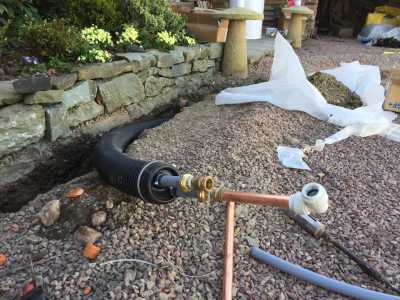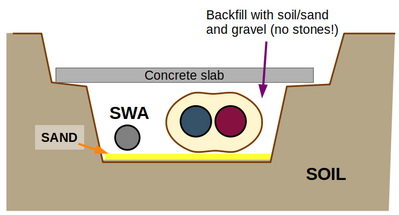Surface mount or bury primaries for heat pump installation?
Hi,
I'm in the early stages of planning my heat pump installation and whilst I know where the pump itself will be sited, I need to work out how to get the water into the garage. The path will see the pipes run up the side access and turn into the garage before getting connected to my heating. The route includes data and power cable.
I have two options.
1. I surface mount the primaries and run them along my neighbour's wall. I then have to either go under the paving or run the pipes up an over. I'll need a bracket of some sort between my neighbour's wall and the heat pump itself as I can't fix them to their failing timber fence.
2. I bury an instulated pipe that holds everything. The problem is that my side access is pretty busy underground with storm, waster and water main pipes. I'm told I should bury the pipe at 600mm, but I don't believe that's possible. At least not all the way. I have photos of this before it was backfilled.
What I want to know is why we can surface mount pipes in insulation, but we're required to put insulated pipes quite deep in the ground.
Has anyone got their primaries buried at a depth less than 600?
Owner of a ridiculously oversized 35kW boiler and trying to make it as efficient as possible. 4.8kW solar PV with 5.4kWh storage. EV driver.
Follow my journey at https://www.youtube.com/@tomasmcguinness
Next big project is a heat pump!
I think I would be wary of attaching my services to a neighbours property without some form of legal agreement to allow this and the required access to them in perpetuity. It also leaves the pipework at the risk of the neighbouring owner, or any future owner, making perfectly legal changes to their property which impacts on your pipe run.
@abernyte That is an excellent point. I hadn't considered that at all! I think I'll be burying a pipe 🙂
Owner of a ridiculously oversized 35kW boiler and trying to make it as efficient as possible. 4.8kW solar PV with 5.4kWh storage. EV driver.
Follow my journey at https://www.youtube.com/@tomasmcguinness
Next big project is a heat pump!
Posted by: @tomasmcguinnessHas anyone got their primaries buried at a depth less than 600?
Yes, ours are buried. 20m run from the heat pump to the utility room. Buried at roughly 50-60cm. I dug the trench myself with pickaxe and spade, because I knew there pipes (waste and gutter run off) underground.
The insulated heat loss pipe is quite pricey from what I can remember.
Pre-order: The Ultimate Guide to Heat Pumps
Subscribe and follow our Homeowners’ Q&A heat pump podcast
@editor My side access already contains services, so it's not easy. I think I'm going to have to shallow bury the pipe as it will need to go over some of the existing services. There is clay pipe down there and I don't want to disturb that.
Is there any solid guidance on buying pipes? I'm less concerned about the water and more about the electrical cable.
Owner of a ridiculously oversized 35kW boiler and trying to make it as efficient as possible. 4.8kW solar PV with 5.4kWh storage. EV driver.
Follow my journey at https://www.youtube.com/@tomasmcguinness
Next big project is a heat pump!
Broadly, the electrical cable will need to be either earthed armoured or in a duct to prevent mechanical damage. Both need to be marked with the required tape.
@tomasmcguinness, because ours runs under our driveway, and I was keen to avoid going too shallow in case it ever got damaged from heavy vehicle deliveries or future resurfacing.
As for guidance on insulation depth, the general 600mm recommendation is more about frost protection and physical damage prevention than some hard and fast requirement (as far as I know anyway). If you’re using decent insulated pipework and you’re not in an area prone to severe frost, going a bit shallower (like 300–400mm) in tight spots should be fine.
In your case, I’d agree that shallow burial with good-quality pre-insulated pipework is a practical way forward. You could always add some additional foam lagging and a protective duct over the section that runs shallower, just to give it a bit of extra mechanical protection.
On the electrical side, the key thing is to use appropriately rated armoured cable, preferably in its own duct separate from the primary pipe, especially if it’s running alongside heat-carrying pipework. It’s also worth checking the manufacturer’s guidance… some kits include pre-bundled solutions, while others require cables to be run independently.
Out of interest, which heat pump are you going with? And who’s installing it? Always helpful context for others following your project too.
Pre-order: The Ultimate Guide to Heat Pumps
Subscribe and follow our Homeowners’ Q&A heat pump podcast
@abernyte I was thinking of an SWA *in* the ducting. I'm looking at a combined water and electrical pipe (uponor or isoflow for example).
Owner of a ridiculously oversized 35kW boiler and trying to make it as efficient as possible. 4.8kW solar PV with 5.4kWh storage. EV driver.
Follow my journey at https://www.youtube.com/@tomasmcguinness
Next big project is a heat pump!
Current thinking is a Kronoterm Adapt. Doing the ground works myself (trench digging, base casting, that sort of thing). Then the professionals will finish the job.
Presently, I'm just exploring my options to get the water from the heat pump into the garage.
I'm constrained by the existing services, so I'm not sure how deep I'll actually manage.
Owner of a ridiculously oversized 35kW boiler and trying to make it as efficient as possible. 4.8kW solar PV with 5.4kWh storage. EV driver.
Follow my journey at https://www.youtube.com/@tomasmcguinness
Next big project is a heat pump!
@tomasmcguinness bold choice on the Kronoterm. Nice! Will be very curious to see how it performs. Have heard very good things about them.
Pre-order: The Ultimate Guide to Heat Pumps
Subscribe and follow our Homeowners’ Q&A heat pump podcast
@tomasmcguinness HI, The rules is a best practise, the heating pipes do not come under the same rules as services such as gas and mains drinking water.
Mostly its for frost protection but when the pipes are only just below the surface it is advisable to well insulate above 100mm thickness to slow losses and mechanically protect if possible.
Professional installer. Book a one-to-one consultation for pre- and post-installation advice, troubleshooting and system optimisation.
Posted by: @tomasmcguinnessI was thinking of an SWA *in* the ducting.
What you run the cable through will affect its current rating (and hence voltage drop).
SWA is intended for direct burial in the ground... the wetter the better.
You want any heat-loss from the cable to be conducted away into the surrounding soil.
Placing a cable inside an air-filled duct has the opposite effect.
The air acts as an insulating jacket. You've just made yourself an underground oven in a long tube. 😥
When you select the required cable size, you would usually enter the figures into an online calculator.
Here's one on the website for TLC-Direct.
That will tell you the cross-sectional area of the copper conductors you will require.
Secondly, if you have any services at shallow depth, where they might get hit by a garden fork for example,
place some basic paving slabs above them.
Although buried electrical cables must also have warning tape above them,
there's nothing like having the fork hit a 40mm piece of concrete slab to warn you there's something down there!
Save energy... recycle electrons!
-
Rodents! A word of warning for heat pump owners
2 weeks ago
-
UFH and ASHPs
4 months ago
-
Installing your own ASHP - DIY
5 months ago
-
ASHP install contract and BUS grant money
6 months ago
-
High air source heat pump running costs – Vaillant AroTherm Plus
7 months ago
- 26 Forums
- 2,158 Topics
- 47.4 K Posts
- 46 Online
- 5,736 Members
Join Us!
Podcast Picks
Latest Posts
-

RE: Help me keep the faith with my air source heat pump installation
@jamespa That flow rate sounds rather high James! Regar...
By Toodles , 1 hour ago
-
@jamespa thanks, I appreciate the offer. For n...
By DREI , 11 hours ago
-
RE: Is Your Broadband Router the Weak Link in Your High-Tech Home?
@transparent what I don't understand about these "rogue...
By Scalextrix , 14 hours ago
-
RE: Who’s Caved and Switched the Heating On Already?
I have 3 women in the house, 2 little ones, so my heati...
By DREI , 16 hours ago
-

@damon thanks. I will do as you suggest. Hopefully I wi...
By bontwoody , 17 hours ago
-
RE: Is a Valliant Inline 6kW heater a BUS buster?
Much of that is true in principle, but its not likely t...
By JamesPa , 2 days ago
-
RE: Heat Pump Servicing & Maintenance – Good Value or Rip-Off?
@dgclimatecontrol I attach the responses from 2 potenti...
By pash44pump , 2 days ago
-

RE: Midea ASHP – how to set weather compensation
Mostly, I think, but with some caveats. I set the TI...
By cathodeRay , 2 days ago
-
RE: Buffers, hot water and cooling
@dgclimatecontrol thanks, that's helpful.
By JamesPa , 3 days ago
-
RE: Failing heat pump system - seeking thoughts on a rebuild
I realise im overdue an update on my situation. first...
By Cleardene-ashp , 3 days ago
-

RE: Replacing Worcester oil boiler with an ASHP
@toodles thanks. I was told by the engineer that this h...
By JulianC , 3 days ago
-

RE: What crazy nonsense are inverter limits and why are they imposed?
A week later, I'm finally picking up this comment... ...
By Transparent , 3 days ago
-
RE: COP is not the only measure of efficiency
We keep all our TRVs fully open using the whole house a...
By Old_Scientist , 3 days ago
-
RE: Havenwise App Help & Forum Support – Get the Most from Your Heat Pump
I am pleased to say at 4pm today we have added another ...
By ASHP-BOBBA , 4 days ago
-
RE: Renewables & Heat Pumps in the News
To unpack this a little.... 1) how many of us in this...
By Lucia , 4 days ago
-
RE: Vaillant aroTherm Plus 10kW thoughts?
@realevil the fans and fan speed / coil size (height, w...
By ASHP-BOBBA , 5 days ago
-
RE: Mitsubishi Ecodan 11kw Defrosting Issue.
@morgan this can just be done by your sepecilist when t...
By ASHP-BOBBA , 5 days ago
-
RE: Anyone still weathering it out with Agile?
@toodles I guess it all comes down to import averages. ...
By Tim441 , 5 days ago
-

RE: 300 Liter Tank - Do I have to heat it all?
The size of DHW tank affects the anti-legionella cycle....
By Transparent , 5 days ago









